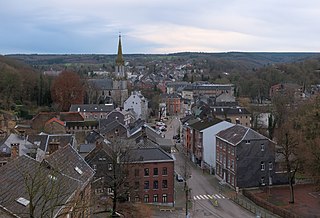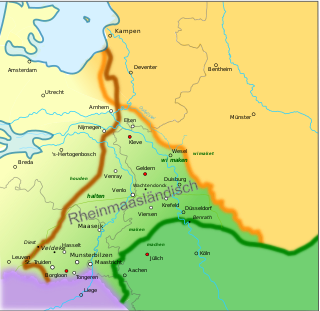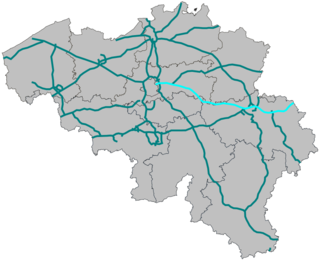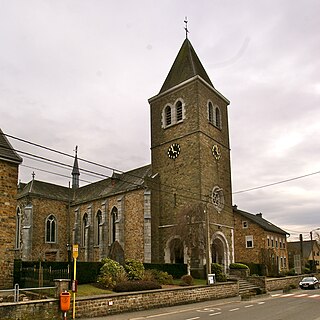
Neutral Moresnet was a small Belgian–Prussian condominium in western Europe that existed from 1816 to 1920 and was administered jointly by the United Kingdom of the Netherlands and the Kingdom of Prussia. It was 1 mile (1.6 km) wide and 3 miles (4.8 km) long, with an area of 900 acres (360 ha). After 1830, the territory's northernmost border point at Vaalserberg connected it to a quadripoint shared additionally with the Dutch Province of Limburg, the Prussian Rhine Province, and the Belgian Liège Province. Its former location is represented presently by the Three-Country Point, the meeting place of the borders of Belgium, Germany, and the Netherlands.

Eupen, is a city and municipality in the Belgian province of Liège, 15 kilometres from the German border (Aachen), from the Dutch border (Maastricht) and from the "High Fens" nature reserve (Ardennes). The town is also the capital of the Euroregion Meuse-Rhine.

European route E 40 is the longest European route, more than 8,000 kilometres long, connecting Calais in France via Belgium, Germany, Poland, Ukraine, Russia, Kazakhstan, Uzbekistan, Turkmenistan, and Kyrgyzstan, with Ridder in Kazakhstan near the border with Russia and China.

The Duchy of Limburg or Limbourg was an imperial estate of the Holy Roman Empire. Much of the area of the duchy is today located within Liège Province of Belgium, with a small portion in the municipality of Voeren, an exclave of the neighbouring Limburg Province. Its chief town was Limbourg-sur-Vesdre, in today's Liège Province.

Eupen-Malmedy or Eupen-Malmédy is a small, predominantly German-speaking region in eastern Belgium. It consists of three administrative cantons around the small cities of Eupen, Malmedy, and Sankt Vith which encompass some 730 square kilometres (280 sq mi). In the area itself, the region is referred to as East Belgium. Elsewhere in Belgium, the region is commonly referred to as the East Cantons.

Meuse-Rhenish is the modern term for literature written in the Middle Ages in the greater Meuse-Rhine area, in a literary language that is effectively Middle Dutch. This area stretches in the northern triangle roughly between the rivers Meuse and Rhine. It also applies to the Low Franconian dialects that have been spoken in that area continuously from medieval times up to now.
Southeast Limburgish, also referred to as Southern Meuse-Rhenish, is a subdivision of what recently has been named Meuse-Rhenish. Both terms denote a rather compact grouping of Low Franconian varieties, spoken in the Limburg and Lower Rhineland regions, near the common Dutch/Flemish (Belgium) and Dutch/German borders. These dialectal varieties differ notably from Dutch and Flemish at the one side, and no less from German at the other. In the Netherlands and Belgium this group is often included in the generic term Limburgish. Limburgish was recently recognised as a regional language (streektaal) in the Netherlands and as such it receives moderate protection under chapter 2 of the European Charter for Regional or Minority Languages. The linguistic border of the Limburgish varieties to the South is the Benrath line, to the North it is the Uerdingen line. This means Southeast Limburgish is different in nature from the other Limburgish varieties.

The Vennbahn is a former railway line that was built partly across what was then German territory by the Prussian state railways. It is now entirely in Belgium, because the trackbed of the line, as well as the stations and other installations, were made provisional Belgian territory in 1919 under an article of the Treaty of Versailles.

The Judicial Arrondissement of Eupen is a judicial arrondissement located in the Walloon Province of Liège, in Belgium. It comprises the 9 municipalities of the German-speaking Community. It is not an administrative arrondissement. All of its municipalities are a part of the Administrative Arrondissement of Verviers, which is divided into two judicial arrondissements.

Low Dietsch refers to a handful of transitional Limburgish–Ripuarian dialects spoken in a number of towns and villages.

The A3 is a Belgian motorway extending from the east of Brussels, through Leuven, onwards to Liège. Just past the ring of Liège, the motorway continues to Verviers, Eupen and the German border.

The Meuse–Rhine Euroregion is a Euroregion created in 1976, with judicial status achieved in 1991. It comprises 11.000 km² and has around 3.9 million inhabitants around the city-corridor of Aachen–Maastricht–Hasselt–Liège. The seat of the region has been in Eupen, Belgium since 1 January 2007. Within a wider context, the region is part of what is called the Blue Banana European urbanisation corridor.

Belgian-German relations refer to interstate relations between Belgium and Germany. Both of these are neighbouring countries and share a common 204 kilometer long landborder. Both nations are members of NATO, the European Union and the Eurozone.

Hauset is a village in the Belgian municipality of Raeren, part of the German-speaking Community of Belgium. The village is around 260m over Mean Sea Level, along the small river Geul and borders the Forest of Aachen. The population, around 1700 inhabitants, is German-speaking and is about half of German citizens who come from the Aachen region. Hauset is on the border to Germany, close to Aachen. Adjacent Belgian villages are Hergenrath, Walhorn and Eynatten.

The Aachen tramway network was the backbone of public transport in Aachen, now in the federal state of North Rhine-Westphalia, Germany, and the surrounding areas from 1880 to 1974. The track gauge was 1,000 mm, see Nordrhein-Westfalen.

The Land of Eupen or Eupen Land, corresponding to the Canton of Eupen, is the northern part of the German-speaking Community of Belgium, lying on the border with Germany. Eupen is the capital of this region. To the south lies the Canton of Sankt Vith, which makes up the rest of the German-speaking Community.

The Hammer Bridge is a 220 metres (722 ft) long railway bridge on the Weser Valley line crossing the Geul valley a few hundred meters to the south of Hergenrath.

Herbesthal railway station was the Prussian/German frontier station on the main railway from Germany into Belgium between 1843 and 1920. It opened to rail traffic on 15 October 1843, and was thereby the oldest railway station frontier crossing in the world. It lost its border status on 10 January 1920, however, as a result of changes mandated in the Treaty of Versailles, which left Herbesthal more than 10 km inside Belgium.

100'5 Das Hitradio is a radio station from Eupen, a town in the German speaking part of Belgium. The station is on the air since 1998 and broadcasts under the motto: "Die Super Hits der 80er, the 90er und das Beste von heute".

The border between the modern states of Belgium and Germany has a length of 204 km (127 mi).



















